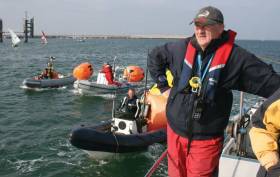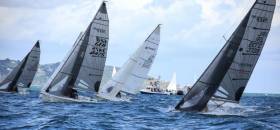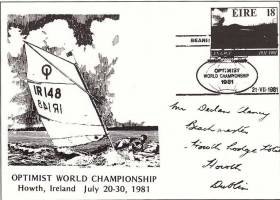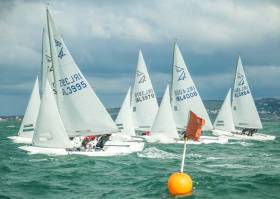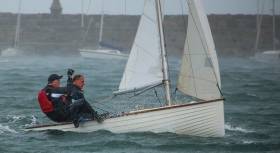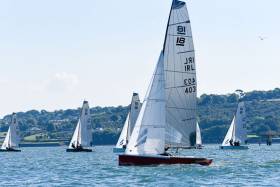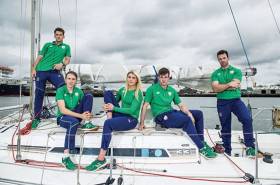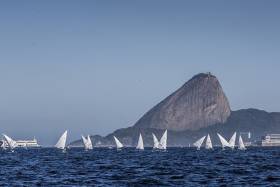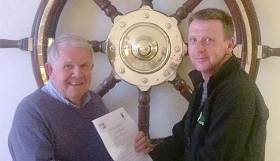Displaying items by tag: Irish Sailing Association
New ISA President Jack Roy Sets Out His Priorities
I am very honoured to be elected as the new President of the Irish Sailing Association – a post which brings with it the need for vision and rigour as well as the potential for ongoing improvement.
The first ISA President was elected in 1945. Over the past 72 years, we have grown to become the national governing body for sailing, powerboating and windsurfing and, along with clubs, classes and training centres, we are committed to developing the interests of our sport at all levels, from day trips to ocean voyages, recreation to cruising, dinghies to keelboats and all those who enjoy activity on the water, be they young or old, beginners to Olympians.
The main aim during my tenure is to highlight the relevance of the ISA to our membership as well as increasing the number of people sailing and becoming members of the organisation. It is vital to stress that it is only through the work of the ISA that freedom on the water is retained, that training at all levels is of the best quality, queries are answered knowledgeably, and racing standards are maintained and recognised internationally.
My term begins in the aftermath of a harsh recession, but there is cause for optimism. Our 2020 strategic plan is being implemented well; ISA membership is increasing; we had a wonderful Olympic success last year; and the economic outlook in many parts of the country is improving. The ISA has a solid and positive plan for the future, but I would like to set out my own key priorities as President:
- To better understand the demographics and culture of the ISA’s membership and build a fuller picture of our sport and community. This, combined with a more robust set of statistics, means we can create and share a story of who we are to all stakeholders
- Our new ISA Club Coaching Programme is rolling out in clubs this year and aims to fill a gap between our core training and the ISA Performance Pathway. The advantages are threefold: a) to convert “summer-course-only” sailors into those who take part in club activity all year round, b) to broaden the talent pool of potential Performance Pathway sailors, c) to expand the circle of club coaches. We will take Olympic expertise from the Pathway programme and use it to develop a stronger coaching culture in clubs
- The “Try Sailing” campaign has run successfully since 2015. Last year, over 3,500 people took part, but now we’d like to focus on how “Try Sailors” convert to club members. The first signs are promising, (almost 50% of clubs who undertook a Try Sailing event in 2016 saw a rise in membership), but how can we ensure that an end-to-end approach is taken, and that we understand and share all the necessary steps to get life-long participants?
Alongside these three priorities, the ISA will continue to develop and support, among others, two specific groups. Third level students are an active group, and we want them to continue sailing after graduation. We will also encourage the participation of women in sailing – through both ISA governance and our “Women on the Water” programme.
Together with the dedicated and professional team at the ISA, our policy group volunteers and our hard working Board, I believe we can create real change, inspire newcomers, and make our sport one that is truly a sport for all, and a sport for life.
I welcome all feedback and I’m happy to discuss issues at all levels. I can be contacted at [email protected]
David Lovegrove stepped down as President of the Irish Sailing Association last Saturday, here is his third and last annual report on ISA activities.
It has been three interesting years for which I am delighted to have had the opportunity of being President of such a terrific sport. The one thing that stands out in my memory is the large number of fantastic sailors that I have had the honour and pleasure of meeting during my term. I also want to acknowledge the support that I have had from my fellow Board Members. The average sailor has no idea of the amount of time that the Board spends working on behalf of sailing and sailors in Ireland.
2016 has been another year of change for the Association and for sailing in Ireland.
However, I am delighted to report that as a sport we are on the up and up, for example:
• According to our Try Sailing statistics, almost 50% of clubs experienced a growth in membership last year
• There have been the incredible results of our high-performance sailors in Rio and a host of other notable successes by Irish Sailors in major events.
• Cruising sailors continue to fly the flag in foreign parts and undertake exciting voyages of fantasy
• A sailor was Grand Marshall at the St Patrick’s Day Parade in Dublin.
Not bad for a minority sport!
Looking back over the past season, one of the successes has been the Try Sailing campaign, which has been a keystone of the Access and Participation Programme. It has taken some time to establish this important brand for the ISA, but it is now very much part of clubs and training centres most used vocabulary. There are many success stories particularly in the small to medium sized clubs around the country where assistance was appreciated in putting this programme together.
We encourage clubs to engage with their RDO early in the season, fix their Introductory Day and start recruiting new sailing members. We were delighted to learn of one club recruiting forty members in 2016 as a result of following through after courses. We were pleased to have the support of the Marine Institute in promoting Try Sailing and look forward to working with them again this year.
Without doubt the highlight of the ISA’s Performance programme in 2016 was the Rio Olympics. Not only did the programme deliver on a long coveted Olympic medal through Annalise Murphy’s heroics, we also had our 49er team of Ryan Seaton and Matt McGovern compete in the medal race final. Andrea Brewster and Saskia achieved a personal best of 12th overall in the 49erfx and Finn Lynch debuted in the Laser as Ireland’s youngest ever helm at an Olympics. The team’s performance was recognised as they picked up “Team of the Year" at the Irish Sports Awards.
In addition, 2016 was also our best ever season at youth level. Ewan McMahon from Howth claimed the silver medal at the Laser Radial Youth Worlds and Nicole Hemeryck was seventh in the girls’ division. Overall the Irish team were the best performing at this event. The rest of the Academy had great results through the season, too many to list here. Our junior sailors were not to be left off the podium and at the Topper Worlds in July our girls filled all three top spots, with Sophie Crosbie from RCYC leading the way. We also had a first in the Optimist class with Tom Higgins winning the British National title.
The representation policy group has been working hard on areas which affect us all and represent the interests of Irish sailors in respect of statutory affaires and legislation. The main focus is to develop a strategy to effect change in the way Government and State Agencies view sailing and lobby to promote safe and responsible participation
Effecting change within the statutory agencies through lobbying is by its nature a slow process and a number of issues are currently under discussion with the relevant departments.
Since the Department of Transport’s request for the ISA to withdraw the ISA’s small craft register on the grounds that it was being used illegally, the ISA has continued its discussions with the Department in introducing the statutory registration system that has been promised. We are informed that work on the implementation of a voluntary register for pleasure craft will commence in 2018 but will depend on the progress of the implementation of an electronic register for commercial vessels currently being developed.
In 2016 the ISA introduced a Certificate of Identity, which incorporates all the services that ISA members avail of in respect of their craft into a single document. This includes racing handicaps administered by ISA, racing sail numbers issued by ISA and other services. It provides details of vessels for use in search and rescue operations and also identifies the person/people taking responsibility for the craft relating to ISA matters.
World Sailing is the International Governing Body for Sailing. In 2016 John Crebbin retired after 19 years of diligent service to the ISA on World Sailing Council. We owe him a debt of thanks for the enormous amount of work he has done on our behalf over the years.
Marcus Spillane who is a member of our Olympic Steering Group has taken John’s place to represent our interests on World Sailing Council, and has worked with us to ensure we had key people appointed onto strategic committees in order to effectively represent the interests of the ISA members.
Dinghy participation in racing appears to have seen a slight increase across many Clubs, while others struggle in areas of lighter population density. RDOs continue to work closely with classes and clubs to assist with event management where required, and to identify local Club ‘pathways’ that will build on local/regional penetration with several Clubs having invested in fleets of double-hander training boats in the last 12 months.
The Dinghy Competition Policy Group was reformed in 2016 to specifically focus on youth transition and retention.
A youth participation survey went out to the 17-30 year age groups with particular emphasis to pass it on to former sailors. This has thrown up some interesting evidence regarding youth attrition:
- 1/3 of all respondents had given up sailing:
- 41% gave work and academic commitments as main reason; 48% gave friends dropping out as 2nd or 3rd reason
- Overwhelming carrot to return to the sport is identified as fun and friends with accessibility to boats and Club membership also being key.
- Several comments on lack of guidance after Optimist sailing.
- Some youth sailors transitioning do not feel they fit in with new class because of age
- 60% of all respondents use a gym regularly, this is a clear opportunity for Clubs
IUSA, Third Level Sailing and Racing, looking to the ISA to provide support and continuity, became another focal point of the group. The potential to expand the use of the varsity Firefly fleets to Clubs on a loan basis while providing team racing during the summer months, to a wider group, is being explored.
Growth strategies for Dinghy Classes will be discussed at the Classes Forum following the AGM. The gap between Try Sailors and Club racers can be bridged. The success of Try Sailing, IUSA connectivity and Clubs looking to streamline their fleets, provide abundant potential to be exploited where classes are willing to put in the legwork.
Event management templates and documents are nearing completion for the ISA online library to assist classes, clubs and colleges to develop standard documents to maintain continuity when administrations change and give Class specific event guidance to host Club and Race Officer.
The Race Officials Policy Group took a number of steps during the year to broaden the scope of the Group to include Measurement, Mark Laying and Safety. This now ensures all aspects of race officials are represented and active within the group. There is now for the first time a Local/Regional and National scheme in place for Mark Layers. With plans in place for Measurement and Safety courses
2016 was the busiest year to date in terms of our continuing drive to deliver educational courses to all disciplines of Race Officials, an area that is critical if we are to delivery top class events both for our local sailors and to attract overseas championships. A total of 16 courses were run in 14 venues throughout the country, with 273 attendees, delivered by 10 instructors who generously give of their time to pass on their expertise and experience.
The ISA Passport System has been successfully rolled out for Race Officials and already over 120 Officials have been logged on.
For the second year since the ISA reengaged with the Eurosaf Officials Exchange Scheme in 2015, we have 5 overseas Judges and Race Officers attending 3 events in Ireland this season and in turn we are sending 5 officials to the events in Denmark, UK, Spain and Germany.
The new Racing Rules of Sailing 2017-2020 is now available on line and in hard copy from the office. In conjunction with this, a number of Rules talks have already taken place and more are scheduled.
While there are no International Championships on our waters this season. we do have a number of large events in addition to all the usual Class Regional and National Championships. For example, the second running of “DinghyFest” in Royal Cork at the end of June is a great opportunity for dinghies to have a terrific event in the company of other classes. July sees the Volvo Dun Laoghaire Regatta which promises to be one of the largest regattas in Europe for Dinghies to Class 0 Cruisers and all classes in-between.
- On the cruising side, the ISA has continued to try to be more involved in this side of the sport. For example:
- A second successful Cruising Conference was held, this time in Cork. A special Cruising Newsletter was published for the conference and to be included in the next ISA Newsletter. Also, a survey and feedback from attendees has been completed and will help inform the structure of next year’s event, which will be held in Dublin
- Support and advice given to the Cruising Association of Ireland.
- Database of Visitors’ moorings maintained and updated
- Advising many sailors on issues mainly around Registration difficulties
2016 was another busy year for ISA Training.
The Staff, Instructor Trainers and Training Policy Group (TPG) continue to work together to improve ISA support to our training centres and developing the skills of our instructors.
The availability of qualified Instructors to clubs and centres remains a key area of attention as we continue to focus on improving the skills, the consistency in standards and the availability of Instructors and Senior Instructors. In 2016, the activity in this area was:
- a total of 84 courses - attended by 515 instructors across sailing, powerboating and windsurfing.
- qualified an additional 57 Senior Instructors
- and added 3 new trainers to the Instructor Trainer panel.
The consolidation of the changes to the Small Boat Sailing Scheme are now complete with all the updated course materials, documentation, training aids and manuals in place for the coming season.
Simplifying the top end of the Small Boat Sailing Scheme is part of the overall strategy to focus it on the development of basic skills in dinghies, keelboats and racing. Coupled with this change, is the strategy to add a new coaching scheme aimed at those sailors and instructors aspiring to take competition to the next level.
The piloting and development work on the new Club Coaching scheme was completed during the year and 2017 will see it being rolled out by clubs and classes around the country. It is hoped that will fill the void that existed previously between ISA training schemes and the activities of the ISA high-performance section.
Working groups have also been active under the TPG in reviewing the existing schemes and the ongoing operation of cruising, powerboat and windsurfing training.
We look forward to the establishment of the Sailing Passport and electronic logbook across our clubs and centres this coming season and welcome the recent appointment of Dave Garvey as ISA Training Development Officer who brings the added knowledge and experience required to better support our centres and further develop training within the ISA.
Another exciting activity will be the development of a cruiser racing training scheme. We are currently in discussions with ICRA on this topic.
I am required under the terms of our Sport Ireland grant to report on our current status in respect of anti-doping. I am delighted to say that in 2016 we had no instances of positive dope testing, which means we remain a drug free sport.
On the staffing side, there have been changes in the roles of the office-based staff along with a clearer focussing of the RDOs to concentrate on the key areas of: Try Sailing, Cruising and Competition.
We appointed a new Head of Communications during the year. Treasa Cox joins us from McKinsey & Company where she held a similar role. Treasa has formulated and is implementing a new communications strategy for the Association which will make use of all communication channels available to us, and which will permeate through the sailing community to our grassroot members.
We have attracted Volvo as our first major sponsor for the Core organisation and we believe that such a prestigious endorsement of Irish Sailing will significantly enhance the profile and reputation of our sport. Volvo’s involvement in sponsoring the 2016 Irish Sailing Awards is, to those that were there at least, an early indicator of the improvements in presentation and professionalism which we will see in future. We are in the complicated throws of updating our computer systems to further enhance communication between the core organisation and members and to streamline the updating of the membership database.
Finally, we expect to announce shortly a further tie-up of significant commercial sponsor again for our core activities. We continue to work at attracting significant sponsorship and support for High Performance and are aware that we have a window of opportunity to exploit the success of our sailors at the Rio 2016 Olympics.
In conclusion, I want to say a most sincere thank you to the staff of the ISA, under the guidance of CEO Harry Hermon, for the unstinting effort that they have put in over the past year and for the support that I have received during the past three years.
World Sailing’s Gold Medal for Ireland’s Helen Mary Wilkes
A lifetime of enthusiastic and effective dedication to voluntary work in international sailing administration has very deservedly resulted in the award of World Sailing’s Gold Medal to Ireland’s Helen Mary Wilkes writes W M Nixon.
She is originally from Scotland while her husband Robert is from England. But when they settled in Ireland in 1969, Howth became their home, sailing became their family sport, and both their sons Tom and Rupert sailed – and still sail - for Ireland.
However, the fact that Helen Mary and Robert together provided a brilliant administrative and creative team was quickly recognized locally and nationally, and it was recognition which became international when Howth Yacht Club took on the staging of the Optimist Worlds in 1981.
 Wall-to-wall Optimist dinghies from dozens of countries at the Worlds in Howth in 1981 – this is how it looks in a double-page spread in the HYC Centenary History, published 1995
Wall-to-wall Optimist dinghies from dozens of countries at the Worlds in Howth in 1981 – this is how it looks in a double-page spread in the HYC Centenary History, published 1995
That would be a relatively straightforward business with today’s modernized facilities. But Howth in 1981 was in the throes of harbour re-development, yet bits of it still functioned as both a sailing and fishing port.
Thus the staging of the worlds was based on the beachside Claremont Hotel immediately west of the Harbour (it has long since disappeared into a large complex of up-market apartments), and much of the running of this huge event had to be developed from scratch.
But with Helen Mary Wilkes in the key position as Secretary to the Organising Committee and Robert in several other roles, the racing for hundreds of Optimists - in what was then the most international sailing event ever seen in Ireland - was successfully completed. The overall winner was Guido Tavelli of Argentina, while the top girl (and best Irish at 17th overall) was 13-year-old Denise Lyttle of the National YC.
 Helen Mary Wilkes (centre) with Viggo and Edith Jacobsen, the founders in 1962 of the International Optimist Dinghy Association, at a major regatta in 1990
Helen Mary Wilkes (centre) with Viggo and Edith Jacobsen, the founders in 1962 of the International Optimist Dinghy Association, at a major regatta in 1990
For most folk in Howth, that was enough involvement in international sailing administration until the new HYC marina and clubhouse were fully functional by 1987. But Helen Mary and Robert Wilkes had been spotted by the powers-that-be as talents that could usefully be deployed on the world stage, and Helen Mary’s subsequent rise through the global and national ranks of sailing administration has been so all-encompassing that it’s best summarized in a basic list:
International Sailing Federation (now World Sailing)
1982 - 1998 International Classes Committee
1990 - 1994 CPOC
1994 - 1998 Events Committee
1994 - 1998 Vice-chair, International Classes Committee (elected)
1998 - 2000 Match Racing Committee
2006 & 2008 Nominated for IOC Women & Sport Award
2008 ISAF President’s Development Award (jointly)
2008-2016 Vice-chair, ISAF Classes Committee
International Optimist Class
1978 - 1982 Secretary, IODA of Ireland
1982 - 1987 President, IODA of Ireland
1982 - 1985 Regatta Committee, IODA
1985- 1989 Vice-President
1989 - 1998 President
During that presidency the Class became the largest in the world:
- national membership rose by 78% to 87 countries
- participation at international events rose by 50% to 57 countries
1998 - 2005 Member of Honour
2005 - President of Honour
Match Racing
In 1996 Helen Mary was asked by Paul Henderson (ISAF President) to promote women’s match-racing towards Olympic status and became the first president of the Women’s International Match-Racing Association. The number of active teams and countries increased by nearly 50%.
Irish Sailing Association
1990 - 1998 Council
1992 - 2000 Olympic Committee/Group
World Sailing
March 2017 Gold Medal awarded to Helen Mary Wilkes by newly-elected World Sailing President Kim Andersen
While Helen Mary Wilkes’ many significant roles have made her the more prominent of this remarkable couple, Robert has been busy behind the scenes, and among other things - in addition to being Secretary for 35 years to the International Optimist Class Association - in 2007 he produced a profusely-illustrated history of the first sixty years of this incredibly successful little boat, with additional input from Clifford McKay Jr, who was the first Opty sailor in Florida way back in 1947.
 Helen Mary and Robert Wilkes on being inducted into the Irish Sailing Association’s Hall of fame in 2009
Helen Mary and Robert Wilkes on being inducted into the Irish Sailing Association’s Hall of fame in 2009
Being the sons of such busy and interesting parents made for a special up-bringing for Tom and Rupert. It’s all of a piece that Tom should be involved on the technical side of sailing – he runs a carbon spar-making business in the Netherlands which, in honour of home, he calls Ceilidh Composites. As a result he is a veteran of several Fastnets and Sydney-Hobarts. Rupert has elected to work ashore, but it’s something equally interesting – he restores classic and antique buildings.
However, this week it’s their parents and their enormous contribution to national and international sailing which is deservedly top of the agenda. Our heartiest congratulations to Helen Mary Wilkes on her newly-awarded World Sailing Gold Medal.
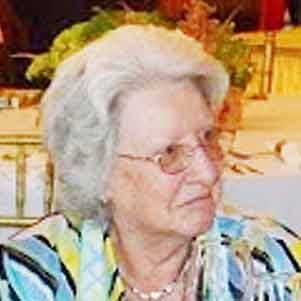 Gold Medallist. Helen Mary Wilkes today
Gold Medallist. Helen Mary Wilkes today
David Lovegrove, President of the Irish Sailing Association, steps down in a week’s time. The conclusion of his three year period in office at the up-coming ISA Annual General Meeting relieves him of what is surely the most demanding voluntary position that Irish sailing can offer. W M Nixon has been finding out more about a busy life with a remarkable record of freely-given service to our sport.
Of all Ireland’s many sports, it is sailing and boating in its numerous forms which has most suffered attrition during the economic collapse after the crazy Celtic Tiger years. Despite efforts to make boat-oriented waterborne activities as affordable as possible through shared ownerships and other club and group schemes, there’s no escaping the fact that it is quintessentially a vehicle activity. It still depends to a large extent on the continuing personal enthusiasm of private boat owners. And expenses inevitably rise exponentially as boat sizes increase.
Yet as the downturn arrived with unprecedented suddenness in 2008-09, sailing and boating groups found themselves with fleets they could no longer afford. They’d clubhouses – many of them listed historical buildings - that seemed increasing like unnecessary luxuries. Recovery was slow, if it occurred at all. In some cases it ddn’t, and the national authority, the Irish Sailing Association, was heading into financial meltdown by 2012-2013.
During the boom years, its expansion had reflected the euphoric national mood. An increasing permanent staff with a rocketing salaries and wages bill led to an unwieldy management structure which was inevitably slow to respond to the new and rapidly-changing circumstances. It was clear that some dramatic gesture was needed to show that there was going to be a complete change of the attitude and ethos of the Association’s governance.
 David Lovegrove (second right) in the family garden in his own-built Fireball Simba at the age of 18, with crewman Joe McKeever on the right. His father gave him £100 to build the boat, but with careful project management, he was able to return £3 to his dad when the job was finished
David Lovegrove (second right) in the family garden in his own-built Fireball Simba at the age of 18, with crewman Joe McKeever on the right. His father gave him £100 to build the boat, but with careful project management, he was able to return £3 to his dad when the job was finished
Under the constitution of the ISA, a new President was due for election at the AGM in the spring of 2014. Normally the new incumbent would be drawn from the ranks of the existing Board members. But there was a reluctance by anyone to allow their name to go forward for what would in effect be a full-time damage-limitation job carried out on a voluntary basis.
And in any case, there was an increasing feeling that things were in such a mess that the only way to show that they were serious about real change was to persuade a respected outsider to take on this thankless task, a poisoned chalice.
In a larger sailing country, the President of the National Authority is a position of dignity and considerable importance. But in terms of our own sailing history, the ISA is of only relatively recent formation. In Ireland, with our almost incomparably long sailing history, we’re in a country where it is thought natural that the senior club should be headed by an Admiral who is treated as an equal - at the very least - by the Admiral of the Naval Service itself.
However, the President of the ISA has not been automatically accorded the dignity his position should merit, unless he or she is a person of such standing in the sailing community nationally that their natural air of authority propels them into a position of equal respect. And in times past, in dealing with the senior flag officers of the major clubs, the ISA President could sometimes feel like a relatively weak mediaeval king dealing with a group of powerful warlords, each with a treasure chest which often out-matched the monarch’s central funds.
But for the ISA, the saviour has become international competition towards Olympic level, which is basically the only form of sailing that the Irish public and Irish government departments understand. The ISA controls this, and thus it is the conduit of a source of public funding which gives it a level of independence from the wayward clubs.
Yet in the final analysis, the ISA goes back to being reliant on the clubs, for it is only through clubs that the Association is able to ensure a ready supply of talented sailors, the best of whom will enable them to tap into the honeypot of central funding for performance athletes.
So there we were in 2013 with most of the clubs severely stretched, and the ISA living way beyond its means, yet in order to get things back on an even keel and bring sailing back to life, a completely fresh President had to agree to take on this hugely demanding job.
It’s not the first time that David Lovegrove of Howth has found himself being unexpectedly propelled into a position of national and international sailing significance from what was almost an outsider position. Back in the 1960s, he was one of the pioneers – led by the great Roy Dickson of Sutton Dinghy Club – who got the Fireball class going to national success. By 1966, Lovegrove had won through to be the Fireballs’ representative in the Helmsmans Championship, raced that Autumn in Enterprises in Kinsale.
The defending champion was James Nixon of Trinity College (DUSC), and though neither of them was to win in Kinsale, Nixon liked the Lovegrove approach to racing, and got to talking with him. He was amazed to find that although Lovegrove was also a Trinity student, he had not thought to get involved with the college’s successful team racing club, as his sailing attention was absorbed with the successful Fireball Simba, which he’d built himself.
“But it’s your DUTY to try and get a place on the Trinity team!” expostulated Nixon. As James Nixon is my brother, I can well imagine the scene.
The upshot of it was that this talented outsider was brought into the heart of the Trinity team-racing fold, and became one of that lineup of college superstars who, in the late 1960s, had won just about every trophy going, in one particular year holding the Irish title, the Northern Universities title, and the British title all at once.
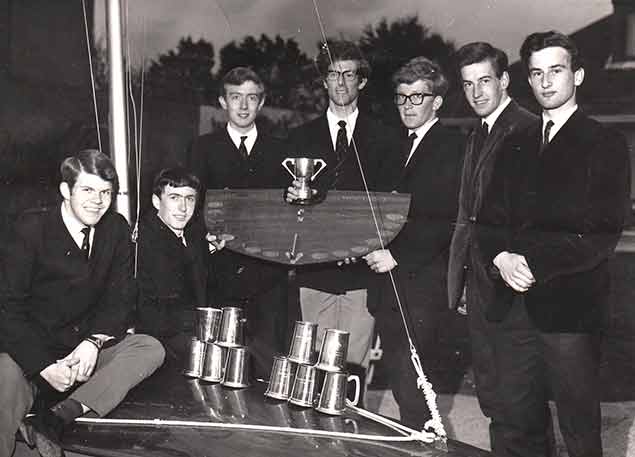 The Trinity heroes. The all-conquering Dublin University SC team of the late 1960s were (left to right) David Lovegrove, Johnny Ross Murphy, Vincent Wallace, Owen Delany, John Nixon, Peter Craig, and Peter Courtney
The Trinity heroes. The all-conquering Dublin University SC team of the late 1960s were (left to right) David Lovegrove, Johnny Ross Murphy, Vincent Wallace, Owen Delany, John Nixon, Peter Craig, and Peter Courtney
From that time there emerged David Lovegrove’s reputation amongst a much wider grouping than Sutton sailing and the Fireball class. He was perceived as an almost diffident steady Eddy type, capable of complete dedication and total enthusiasm when it was most needed. In the Autumn of 2013, Irish sailing administration needed it very badly indeed. Although initially Lovegrove rejected out-of-hand the idea of being parachuted abruptly into the ISA Presidency, a friend from those very special years of the late 1960s, Brian Craig - the quintessential backroom operator of Irish sailing - eventually persuaded him that he was the only man for the job, and he took it on in the Spring of 2014.
So who is he, this man who stepped into this hottest of hot seats when it was a very cold place, and all within a very short period of retiring from a demanding international career, while his own personal involvement in sailing was increasingly committed to high level Race Officer activity?
 It was on Nairobi Dam in the 1950s that David Lovegrove started sailing, with International Cadets, Fireflies, and International 505s. His father was probably in charge of the track on which the old steam train is running on the far shore of the lake
It was on Nairobi Dam in the 1950s that David Lovegrove started sailing, with International Cadets, Fireflies, and International 505s. His father was probably in charge of the track on which the old steam train is running on the far shore of the lake
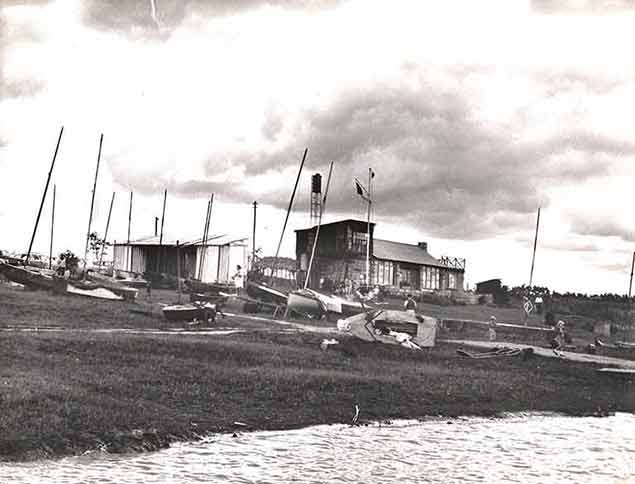 Sailing nursery. The Aqua Club on Nairobi Dam – David Lovegrove’s first sailing was with the International Cadet in the foreground, on its side for work on the mast
Sailing nursery. The Aqua Club on Nairobi Dam – David Lovegrove’s first sailing was with the International Cadet in the foreground, on its side for work on the mast
Although born in 1947 to a family living on the Sutton waterfront facing southwest into Dublin Bay, his father – a railway engineer – wasn’t into sailing, and in the early 1950s the stagnating Irish economy persuaded him to move his family to Kenya. It was there, at the age of eight or nine, that a school friend from a sailing family introduced him to the wonders of it all on nearby Nairobi Dam. He was completely hooked - “smitten” is the word he still uses today. In short order, his newfound enthusiasm took him through International Cadets, Fireflies, and on into the exalted heights of the International 505 class. But while the sailing on the lake was idyllic, the political position in Kenya was rapidly deteriorating. In 1963 the Lovegrove family returned to Ireland and the house in Sutton, and his mother, concerned at her sixteen year old son’s need to adjust to the Irish climate, bought him a classic duffle coat which he keeps for good luck to this day, though it’s now well-covered with glue and paint from his boat-building habit.
Ten years earlier, he’d been unaware of Sutton Dinghy Club, but now he went along to see what was happening, and met up with Ian Sargent who, even then, was promoting the IDRA 14 class with total single-mindedness. The class in Sutton had a boat with a girl owner, Eleanor Hazleton, who didn’t like steering. For three years through Sargent machinations, David Lovegrove helmed her boat while she crewed, and the boy just back from Kenya got drawn ever deeper into Irish sailing.
 Simple spot. Sutton Dinghy Club as it was when David Lovegrove - recently returned to Ireland from Kenya - joined it in 1963.
Simple spot. Sutton Dinghy Club as it was when David Lovegrove - recently returned to Ireland from Kenya - joined it in 1963.
The development pace was being set in Sutton by the ever-enthusiastic, always-obliging Roy Dickson whose workshop was available to anyone with boat plans, and in 1965 David Lovegrove’s father provided his son (aged 18) with £100 to build a Fireball. Always one to keep meticulous records, young Lovegrove built his new Simba as economically as possible, and when the boat was ready to sail, he totalled his final figures and was able to return £3 to his dad.
Crewed by the likes of Joe McKeever, Nat Healy, and then Vincent Wallace who was to be a team-mate in the stellar Dublin University all-conquering squad, young Lovegrove found himself competing in the Fireballs in a decidedly eclectic group of all ages, abilities and backgrounds. It gave him an unrivalled overview of the Irish sailing scene at its most diverse, and provided close friendships which have lasted to this day.
Meanwhile in life ashore he graduated from Trinity, married Kate Chillingworth who more than tolerated his sailing and boat-modifying enthusiasms, and started a family. They now have two daughters, Sarah and Joanne, both of them sailors. And David himself began a distinguished career with the Industrial Development Authority, helping to build a new Ireland which was remote indeed from the stagnating place he and his parents had left in the early 1950s.
While busy with his work at home and abroad, he continued sailing as much as possible, and in the late 1970s his focus shifted across the peninsula to Howth as he reckoned the rapidly-growing Squib class there provided the ideal boat for family use while also meeting the needs of the man of the house, who was mad keen on racing. Howth was in its rapid development stage, with the new marina opening in 1982, and the Lovegroves moved up in boat size in 1983 to the newly-introduced Puppeteer 22, a boat-with-a-lid, albeit a small one. As with their Squib, the boat’s name was Snowgoose, and many a trophy she added to the list.
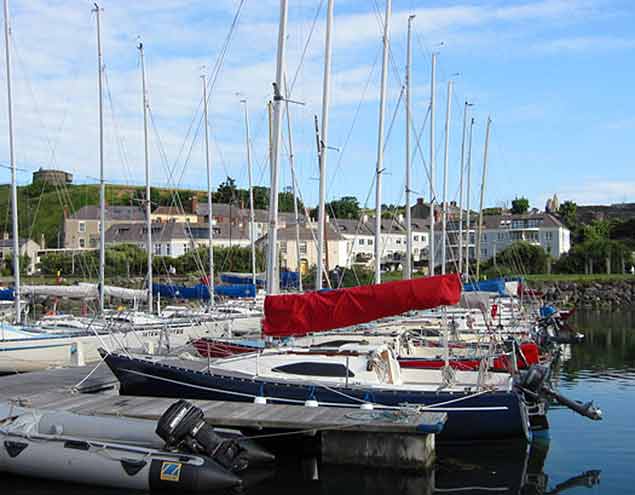 The Puppeteer Class at Howth. One of the most successful local classes in the harbour, the Lovegrove family have owned one of them since the class’s inauguration in 1983. Photo: W M Nixon
The Puppeteer Class at Howth. One of the most successful local classes in the harbour, the Lovegrove family have owned one of them since the class’s inauguration in 1983. Photo: W M Nixon
Howth Yacht Club in its period of greatest expansion needed calm, capable administrators and negotiators, and David Lovegrove soon found himself drawn into various committees and sub-committees. But in addition to continuing as a keen sailor, he was further developing another of his interests afloat – as a Race Officer, where he acquired international status. He was involved in running the famous Admirals Cup trials of 1987 at Howth, where the Chairman of the Selectors, Clayton Love, insisted that racing continue despite the 50 knots-plus of wind. The race team of Jock Smith and David Lovegrove obliged, even if it did mean that at one stage the Dubois 40 Jameson was all over the place waving her legs in the air, while the committee boat rounded out their day by rescuing a capsized mark boat, a Dory, which had headed skywards over a steep breaking wave, and just kept on going until she’d looped the loop.
 The Dubois 40 Jameson struggling with 50-knot gusts at the Admirals Cup trials at Howth in 1987. Photo: Rick Tomlinson
The Dubois 40 Jameson struggling with 50-knot gusts at the Admirals Cup trials at Howth in 1987. Photo: Rick Tomlinson
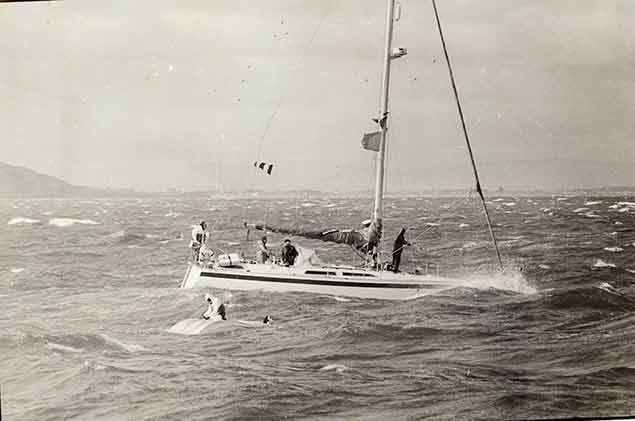 The winds were so strong at the 1987 AC trials that a Dory heading into the waves looped the loop. David Lovegrove is at the helm of the Committee Boat now doing rescue duty. On the upturned boat is Brian Jennings, for whom David Lovegrove had built a Mirror Dinghy with which young Jennings won the Irish Mirror Nationals
The winds were so strong at the 1987 AC trials that a Dory heading into the waves looped the loop. David Lovegrove is at the helm of the Committee Boat now doing rescue duty. On the upturned boat is Brian Jennings, for whom David Lovegrove had built a Mirror Dinghy with which young Jennings won the Irish Mirror Nationals
With the new marina-side clubhouse completed in March 1987, Howth’s sailing potential had moved up several gears, and inevitably David Lovegrove’s talents were recruited towards the flag officer stream, with the powers-that-be positioning him so neatly that he was right on the starting grid to become Commodore as Howth YC’s Centenary came up over the horizon in 1995. Thus it was he and Kate who welcomed President Robinson to the Club for the Centenary Fleet Review, the highlight of a busy season in which Howth boats were achieving notable success at home and abroad.
 It’s the Howth Yacht Club Centenary in 1995, and HYC Commodore David Lovegrove and his wife Kate welcome President Mary Robinson to the club. Photo courtesy HYC
It’s the Howth Yacht Club Centenary in 1995, and HYC Commodore David Lovegrove and his wife Kate welcome President Mary Robinson to the club. Photo courtesy HYC
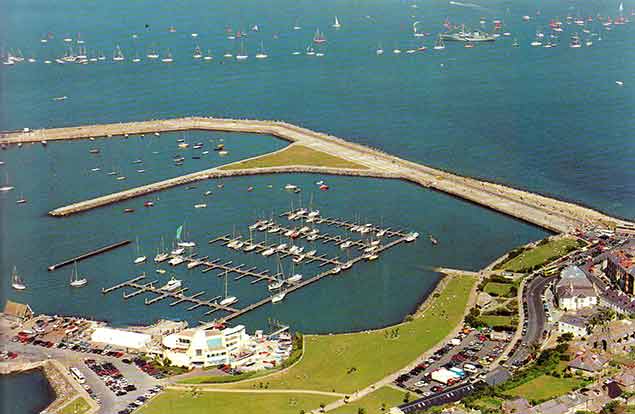 Fleet review. With President Robinson reviewing the Howth YC Centenary Fleet from the Guardship, the marina is almost empty. Photo courtesy HYC
Fleet review. With President Robinson reviewing the Howth YC Centenary Fleet from the Guardship, the marina is almost empty. Photo courtesy HYC
While he continued as an avid race with the Puppeteer 22s – he’s a One-Design man through-and-through – he was ever ready to take on some boatwork task, and back in the day he’d built each of his daughters optimised Mirror dinghies. In fact, his workmanship was so impressive that the local GP, Damien Jennings, had asked him to build another Mirror for his son Brian, offering wads of cash. Yet all David wanted was the cost of the materials to be covered, as he found the task sufficiently rewarding in itself. But inevitably it ended up being done in the winter, and one night it was gone 9.0pm when he finally got stuck into the next task in the garage-cum-boatbuilding-shed, installing the boat’s tanks with the garage doors and windows sealed off, and the heaters going full blast.
Anyone who ever built a Mirror will recall that while most of it could be done alone, at certain stages a second pair of hands is essential, however briefly, and on that night this stage occurred at 1.30 am. There was nothing for it but to waken Kate who had been long asleep, and beg for her help. She hauled on her dressing gown, threw an old rug on the garage floor, and slithered in under the boat to provide that vital bit of back-up at the key moment, while glue dripped on her forehead.
The job done, her husband relaxed, and started smothering her with thanks in profusion. “What on earth were you thinking” he asked, “lying there on the cold floor of the garage with the glue dripping on your face?”.
“I was thinking” she said, “of Damien and Bernadine Jennings snug at home and well asleep in their warm bed”. But the boat was a winner – young Brian Jennings went on to win the Irish championship with her.
David Lovegrove took early retirement from the IDA at the age of 55, but that was only to enable him to set up an international consultancy which took him all over the world for the next dozen years, advising governments in countries as diverse as Chile, Uruguay, Brazil, Colomibia, Peru, Surinam, every country Central America and many other places in the Middle East down to Sudan.
At home between these extensive travels, he became ever more immersed in the world of race management, and over the years built up a team around him, a team now functioning so smoothly like a well-oiled machine that they can simply transfer the entire squad to whatever location needs race management services. But given the choice, they prefer to operate from Howth’s own larger Committee Boat Star Point, which has been cleverly modified to David Lovegrove and his team’s suggestions, coupled with the suggestions of other top Howth race officers like Derek Bothwell, to provide a formidable race management platform.
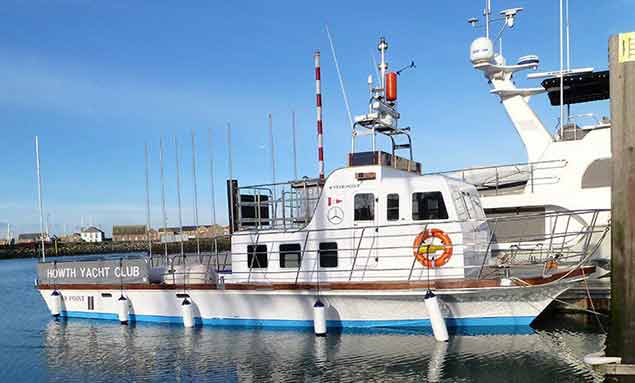 Star Point, the larger of HYC’s two Committee Boats, may not be the most handsome vessel afloat, but with clever modifications suggested by David Lovegrove and other experienced race officers, she is one of the most effective committee boats in the country.
Star Point, the larger of HYC’s two Committee Boats, may not be the most handsome vessel afloat, but with clever modifications suggested by David Lovegrove and other experienced race officers, she is one of the most effective committee boats in the country.
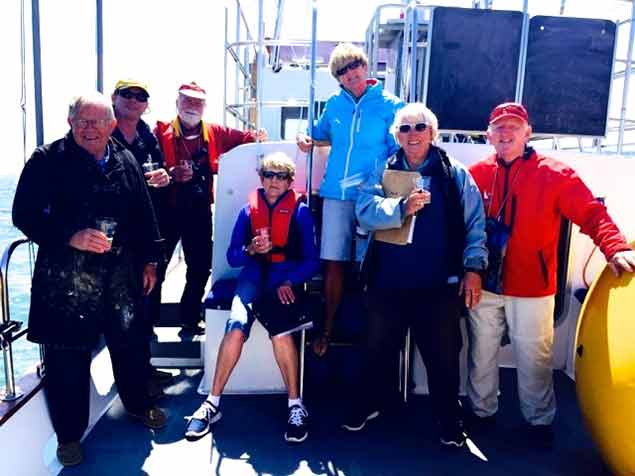 The Lovegrove Race Team on Star Point at last year’s ICRA Nationals at Howth are (left to right) David Lovegrove with his notorious 1963 duffle coast, Algy Pearson, Rupert Jeffares, Suzanne Cruise, Judith Malcolm, Kate Lovegrove, and Harry Gallagher
The Lovegrove Race Team on Star Point at last year’s ICRA Nationals at Howth are (left to right) David Lovegrove with his notorious 1963 duffle coast, Algy Pearson, Rupert Jeffares, Suzanne Cruise, Judith Malcolm, Kate Lovegrove, and Harry Gallagher
As to the day job with its extensive travelling, he’d made a deal with himself that when the homeward journey became more exciting than the outward journey, then he’d jack it in, and that stage started to arrive four years ago. But he’d barely settled in to his new more relaxed situation when the ISA came calling, and for the past three years life has been very hectic indeed.
The ISA has had to be slimmed down, shedding projects like the J/80 Sailfleet flotilla, and he went strongly with the idea that a Strategic Review should be undertaken, run by key people like Brian Craig and former President Neil Murphy.
That review came down firmly in favour of re-emphasising the role of clubs in the ISA support structure. Though it didn’t meet with total approval throughout the sailing community, particularly among those who run commercial sailing schools, at least a marker could be put down, and work could begin on improving relations with every area of sailing, for things had come to such a sorry pass that various specialist groupings were at each other’s throats, and also frequently into loudly attacking the ISA when they felt so inclined.
With his patient ready-to-listen attitude, and his willingness to travel in pursuit of opinions, David Lovegrove was the right man for the long slow progress of peace-making and creative negotiation, which will continue. He insisted that the Board meet monthly, and that it move its meeting place around the country in order to give every area a sense of direct involvement and promote Try Sailing projects.
All this was time consuming and decidedly unspectacular, but it was very necessary, and even as this sometimes dull but essential work continued, things were happening to give Irish sailing a fair wind. In 2014, Ireland re-took the Commodore’s Cup under the inspired captaincy of Anthony O’Leary, and as he was at the time also the ISA All-Ireland Champion, the stardust rubbed off on everyone.
Despite the lingering effects of the setbacks of the recession, people were getting out and winning major events in boats which were no longer in the first flush of youth, but were all the better sailed for that, and almost invariably it would be noticed that the President of the ISA, in addition to his many duties, was as usual working aboard a Committee Boat making sure that races were run with punctilious precision.
Gradually a greater level of civility returned, and the mod was good as 2016 came upon us to provide the greatest Irish sailing season ever, starting with a bronze medal in the Youth Worlds for Dougie Elmes and Colin O’Sullivan, going on with success for everyday Irish sailors at home and abroad, then too we’d a fabulous Volvo Round Ireland Race from Wicklow, there was a brilliant innovation with the Beaufort Cup series in Cork, an international dinghy regatta to top all others with the Laser Radial Worlds in Dublin Bay when our own Ewan MacMahon won Silver, and then an excellent all round showing in the Rio Olympics topped by Annalise Murphy winning the Silver Medal.
No-one deserved this overall success more than the patient and dutiful David Lovegrove. Typically, though, he wasn’t there on the beach in Rio when Annalise Murphy brought Ireland and the world to a halt with her cliff-hanger win of the Silver Medal. On the contrary, he was in Plymouth in southwest England, fulfilling a longterm commitment to be Race Officer at the J/24 Europeans.
That’s the way it is with David Lovegrove. Duty will always come before celebration. But apart from steadying the ship at a time when the ISA and the Irish sailing community were going through a very rough time, he has brought an extra dignity to the role of ISA President. He may be small in stature, but David Lovegrove is a big man in his approach to the problems of life. He quietly withstood some seriously vindictive yet totally undeserved personal attacks when he first took over the post of President. For a while, things were very unpleasant. But he has stood his ground and has listened with courtesy to all points of view.
Thanks to his approach, the position of President of the ISA is now beginning to receive the respect it deserves as a special position, regardless of the personal situations which may arise from time to time. For that alone, Irish sailing should be very grateful to David Lovegrove. But we’ll continue to be grateful to him for many years yet, for as soon as the new season swings into action, he’ll be there on the starting line with a season’s programme of race organisation which would be beyond many men half his age.
Throghout all this, his wife Kate has been the rock on whch has been able to rely. Late in the Spring of last year, she realised it was all in danger of becoming overwhelming, so she whisked him away for five weeks clear of everything to do with Irish and international sailing. She did this with the trip of a lifetime to China on the Trans-Siberian Express, which does indeed get across Siberia, but “express” is stretching it bit. However, the President returned to Ireland completely refreshed to see out one marvellous sailing season which he very richly deserved.
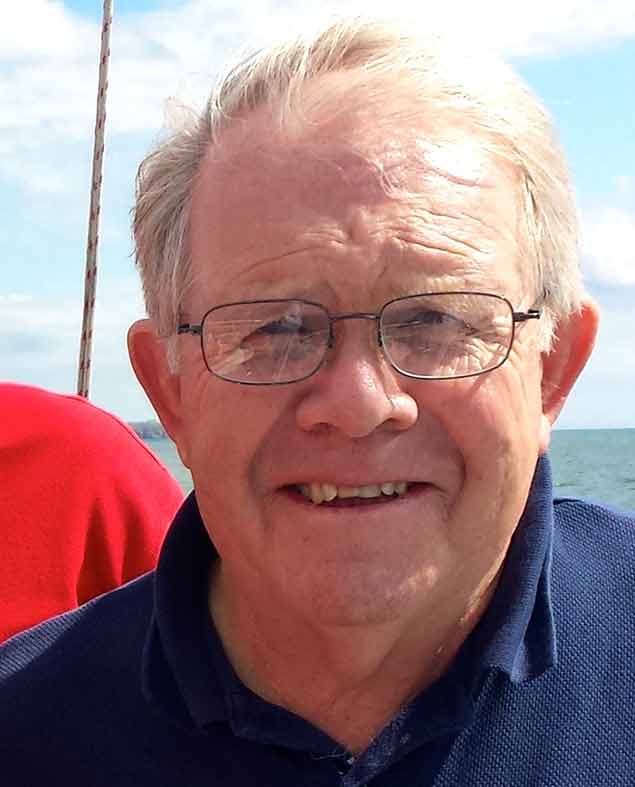 With his three year ISA Presidency completed in a week’s time, David Lovergore is looking forward to a busy season as a Race Officer at home and overseas – and he might even get to do some racing himself on his Puppeteer 22 Snowgoose. Photo: Judith Malcolm
With his three year ISA Presidency completed in a week’s time, David Lovergore is looking forward to a busy season as a Race Officer at home and overseas – and he might even get to do some racing himself on his Puppeteer 22 Snowgoose. Photo: Judith Malcolm
Sailing is Recovering After 'Famine Years' Says ISA CEO
Sailing is in recovery mode after six or seven years of famine. That is the opinion of the Chief Executive of the Irish Sailing Association, Harry Hermon.
This week he told me frankly that the sport had struggled over the past few years, particularly from the effects of the recession. Yacht clubs had suffered and the larger clubs had been hit hard he said. But over the last year or two more boats and more people have come into the system.
“There is more positivity out there now and that is really good. Things are looking good at the moment.”
Sailing has been bedevilled by the image of being an elitist sport and he said that the ISA was dealing with this.
Listen to my interview with Harry Hermon here on this Podcast edition of THIS ISLAND NATION maritime radio programme below which also hears from a company on the East Cork coastline that is setting new trends in the design of special boats including one with “stealth” capabilities to conceal its presence when used by security, Naval and military forces Safehaven Marine at Youghal is also planning to set a new speed record around Rockall this Summer, which are outlined by the man who set it up, Frank Kowalski.
IDRA 14s 70th Anniversary Dinner at Royal St. George YC This Saturday
The 70th Anniversary of the IDRA 14ft OD dinghy class has been marked in spectacular style throughout the 2016 season writes W M Nixon, with the latest newly-built classic clinker boat (no 166) being launched in June, a well-supported and hard-raced Annual Championship at Lough Derg Yacht Club at Dromineer in August, and a two day celebration afloat and ashore at one of the class’s spiritual homes, Clontarf Yacht & Boat Club, in September. This convivial event was well attended by IDRA 14 sailors past and present - some from very far back – together with a boat and support team from the IDRA 14’s sister class, the Dragonfly OD at Waldringfield Sailing Club in Suffolk. Read Afloat.ie's review here.
However, in the final analysis it’s arguable that the genesis of the class was born within the Royal St George Yacht Club in Dun Laoghaire from the productive minds of Billy and Jimmy Money, together with Douglas Heard.
Douglas Heard was later RStGYC Commodore in addition to being founding President of the Irish Dinghy Racing Association, owner of IDRA 14 Number 1, and winner of the first Helmsman’s Championship in 1947. So all the logic pointed to rounding out the 70th Anniversary Season with a Gala Dinner this Saturday (October 15th) in the Royal St George Yacht Club, and although it’s already well-booked, we’re told there are still some places left which will be of interest to the hundreds of people who have been involved with this remarkable class at some time during the past 70th year.
One of these is Irish Sailing Association President David Lovegrove who raced IDRA No 107 Spray at Sutton Dinghy Club during the 1960s, and he and his wife Kate will be mingling with fellow enthusiasts who will all be talking clinker nine to the dozen on Saturday night. If you’re comfortable with the technology you can make your dinner bookings on line through the RStGYC website, if any queries please ring Ian Sargent at 087 6791069 or Suzanne McGarry at 087 2425331.
Those already booked for the dinner are bringing along IDRA 14 memorabilia including photos going back seventy years, and if you happen to have something in that line yourself you’ll be doubly welcome.
Irish Sailing Association Seeks Nominees for Junior & All Ireland Sailing Championships
The Irish Sailing Association is inviting class associations to make nominations for the ISA All Ireland Sailing Championship and ISA All Ireland Junior Sailing Championships 2016.
The ISA All Ireland Junior Sailing Championships on September 24th – 25th at Fastnet Marine & Outdoor Education Centre, Schull, Co. Cork. The event will be sailed in FMOEC TR 4.2 class two person dinghies.
The ISA All Ireland Sailing Championship on October 1st – 2nd at Royal Cork Yacht Club, Crosshaven, Co. Cork. The event will be sailed in National 18 three person dinghies.
The ISA is seeking three nominations from each of the senior classes. The junior and youth classes will be advised on the number of places allocated for that class as per notice of race. Nominations will be only accepted from classes whose affiliation fee is paid for 2016.
Class associations are also invited to suggest candidates for a wild card place; these would be members who have excelled at an International competition in the class during the year.
The age limit for the Junior Sailing Championships is under 19 years on December 31, 2016. If a class holds a junior/youth national championship for eligible sailors they may nominate to the Junior championship in the same way and enclosing a copy of the relevant Notice of Race. Please see the Notice of Race for both events below.
The ISA says its policy of a National Race Officer managing racing at a class’s national championship will be strictly applied.
The deadline for nominations is: ISA All Ireland Junior Sailing Championship is 1500hrs on the 12th of September, 2016 and 1500hrs on the 19th of September for the ISA All Ireland Sailing Championships
The Future of Sailing is Bright
In one of our quarterly reviews, ISA President David Lovegrove shares his views on the incredible “spring” into 2016 and the effect Try Sailing is having on participation
A key goal of the ISA is to attract more people into sailing. The “Try Sailing” initiative which was launched in late 2015 is a fundamental part of the ISA’s programme to encourage more people to get involved in sailing and I am very pleased to report that it has been embraced by Clubs and Centres all around the country.
Try Sailing is exactly what it says. It provides opportunities to get out on the water and experience sailing for yourself, and 2016 has seen a fantastic increase, with 80% of clubs organising open days and taster sessions aimed to make sailing more accessible to newcomers. Along with these open days, there are schools programmes, support from Local Sport Partnerships, “Women on the Water” programmes and numerous new initiatives nationwide. One new programme to give new Try Sailors the chance to enter a high adrenalin event and try cruiser racing, is the new initiative of the ISA Try Sailing Invitational Challenge which ran during Volvo Cork Week with Royal Cork Yacht Club using 1720s.
There is no better ambassador for sailing than a sailor. So next time you go out on the water, invite a friend, relation or neighbour to get on board and “Try Sailing”. Just imagine if every one of us converted one person to becoming a sailor this year!
All of this activity takes place against the backdrop of this being an Olympic year and the profile of our elite sailors performing in Rio will give our sport added impetus over the summer months and will act as a beacon, particularly for young people. We have a very exciting team representing Ireland and competing in five disciplines including John Twomey, Ian Costello and Austin O’Carroll in the Sonar class at the Paralympics. This will be John’s 11th Paralympic appearance and we are honoured that he has been selected as the Paralympic flag bearer during the opening ceremony. Annalise Murphy gave an incredible performance in Weymouth in 2012 and will be representing Ireland in the Women’s Laser Radial fleet again this year. Men’s skiff sailors Ryan Seaton and Matt McGovern will be in the 49er fleet, their second Olympic campaign, and they will be looking to push past their 14th place achieved in Olympics 2012, especially considering their recent great results. First timers to Olympic games performance are the impressive duo Andrea Brewster and Saskia Tidey with the 49erFX and, of course, the youngest helm to represent Ireland, Finn Lynch at 20 years old, will be sailing in the Laser Standard Men’s fleet. It is marvellous to have such a balance of gender and experience representing Ireland this year. Their hard work and dedication over these past four years to gain qualification for Rio is an inspiration. 66% of this team are graduates from the ISA Academy programme, which continues to help our young sailors improve their performance sailing skills. So, I hope you will all join me in getting behind our sailors and giving them your full support as they enter the lions’ den. On behalf of the ISA, I wish them every success – go Ireland.
Is it all this inspirational activity, favourable sunshine or a change in the world economy that has so many sailors coming out of hibernation this spring and travelling to events? The Volvo Round Ireland Race had a huge increase in boats entering this year, as well as a selection of truly impressive vessels. I was particularly delighted to see a number of Irish Cruising Schools enter the event, introducing novice sailors to offshore racing.
The ISA recently renewed its long–standing agreement with the Irish Cruiser Racing Association and agreed a plan to support one another in a campaign to develop Cruiser Racing in Ireland. ECHO and IRC handicap fees are being reinvested into the development of Cruiser Racing and “Crewpoint” (promoted to help bring skippers and crew together nationally) and new crew opportunities made available through Try Sailing Try Crewing, should all help to rejuvenate this sector.
If all this talk of racing on our horizon has you exhausted then the ISA has a new coastal cruising routes guide to help you decide where to escape for a leisurely sail. This guide will give ideas on where you may like to anchor up, fill up or venture ashore, all given by local experienced sailors and edited by Norman Kean of the Cruising Policy Group. Cruising sailors will also be pleased to hear there are plans afoot to bring a Cruising Conference to Cork in early 2017.
We are entering a very exciting period for Irish sailing and we can look forward to a very positive summer of competitive and leisure sailing. Enjoy the sailing, and hopefully the weather, and I’ll catch up with you all again shortly.
Olympic Sailing Team – Two Months to Improve Before Rio
After a weekend of poor Irish performances at the British round of the Sailing World Cup, the Irish Sailing Association has acknowledged results from Weymouth were 'far from ideal'.
The Sailing World Cup on the Dorset coast, billed as the 'final opportunity for sailors to lay down a marker before the Rio 2016 Olympic Games', was attended by 380 Olympic sailors from 44 nations.
Men’s skiff sailors Ryan Seaton and Matt McGovern from Belfast reached the medal race final which they led for its entirety before sailing the wrong course to the finish line.
London 2012 veteran Annalise Murphy, Ireland’s most successful sailing athlete in the last 30 years, had one of her most disappointing results of the season when she placed 34th in the 39–strong Laser Radial fleet. Murphy has been concentrating on preparations for her second appearance at the games but the Rio venue offers much lighter winds to four years ago when she narrowly missed a podium result.
Andrea Brewster and Saskia Tidey in the women’s skiff placed last in the 49erFX event.
“We have two months to focus on the things we can improve before starting the Olympic regatta in Rio', Team Manager James O'Callaghan said yesterday.
Men’s single-hander Finn Lynch, the youngest ever Irish helm to be selected for Team Ireland did not take part in the regatta due to training-camp commitments in Croatia.
The 49er pair have one further regatta at Kiel Week in Germany later this month before final preparations begin for their second Olympic appearance at Rio 2016 in August.
The first race in the Rio 2016 regatta begins on Monday 8th August when Murphy and Lynch begin their respective events.
A facebook campaign update from the 49er crew:
The Irish Cruiser Racing Association (ICRA) and the Irish Sailing Association (ISA) have signed a Memorandum of Understanding (MOU) for the two associations to work closely together to support cruiser racing efforts. Initiatives such as ICRA's crew training 'Crewpoint' resource will be developed further to help give crew and boats an easier path to matching up opportunities to race together.
Crewpoint will help to unite crew with skipper and boat, as well as create a greater awareness of access to sailing. For non boat owners ICRA, Crewpoint and the ISA are linking up with the Try Sailing campaign to create access points for more people to give sailing a try and to encourage more sailors to give racing a try in open days, crewing opportunities and events.
To help support the development of Cruiser Racing in Ireland all ECHO and IRC handicap fees are reinvested in the development of Cruiser Racing.



























